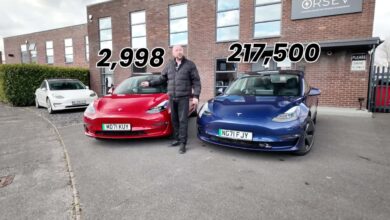An Electric Chevrolet Corvette? GM Is Thinking About It

If you’ll indulge me with a personal story for a moment: when I was in high school, my father bought himself an NB Mazda Miata. But I wasn’t allowed to drive it. It was a five-speed manual, and he was convinced I’d either wreck the car or the gearbox or both. Then, when I came home to visit from college one day, I learned he traded up to a C5 Chevrolet Corvette Z06. And he said I had to drive it.
The Miata was too much for me, but the car with about three times as much horsepower? Good to go. Dad logic, you might call it.
All of this is to say that learning to drive stick on that Corvette left me with a soft spot for America’s sports car. Yet the whole world is electrifying now. Where does that leave a performance car that’s so deeply linked to the V8 engine?

Photo by: Chevrolet
Chevrolet Corvette Hypercar Concept (UK)
Well, if this design study bears out, then we don’t have anything to worry about. This week, General Motors unveiled a new “advanced design study Chevrolet Corvette concept car”—the first of several to be revealed this year, apparently—that could in some way preview a potential future all-electric Corvette hypercar.
It’s crucial to note that this is in no way a final design, nor has GM given us any new details about a confirmed all-electric Corvette beyond some past statements by executives. But the fact that it exists at all shows that GM is clearly thinking about this sort of thing, both in looks and what Corvette fans would want out of it.
“It was important that they all pay homage to Corvette’s historic DNA, but each studio brought their own unique creative interpretation to the project,” Michael Simcoe, GM’s senior VP of global design, said in a company blog post. “That is exactly what our advanced design studio network is intended to do—push the envelope, challenge convention and imagine what could be.”
Here’s a video preview from the folks at Top Gear:
Interestingly, the design work was done by a UK-based team, in something of a departure from the Corvette’s usual all-American origins. (Then again, the Corvette itself exists thanks to immigrants and the children of immigrants, like Zora Arkus-Duntov and Larry Shinoda, so it’s more than a great metaphor for the country itself.)
And speaking of history, this concept plays home to one of the most famous design touches ever: the “split rear window” 1963 Chevrolet Corvette Sting Ray. This concept packs a vertical line that runs along the front window as well, evoking vintage race cars. It’s also longer, wider and lower than even the current C8 Corvette.
But make no mistake: this bad boy is intended to be all-electric. “The exterior design includes a distinctive division between the upper and lower halves of the vehicle,” GM said. “The upper half captures the Corvette’s classic design elements, but in a futuristic manner. The lower half focuses on functional technical design, including EV battery technology embedded into the structure and aerodynamics elements designed to channel air efficiently without the need for wings or spoilers.”

Photo by: Chevrolet
Chevrolet Corvette Hypercar Concept (UK)
Consider me a fan of the design. Will GM actually build it? In the past, execs like GM President Mark Reuss have said the automaker aims to “offer an electrified and a fully electric, Ultium-based Corvette in the future.” The former already exists in the form of the Corvette E-Ray, which is one of our favorite hybrid cars. But it’s unclear now if GM will pull the trigger on an all-battery Corvette, and if so, whether it’d be a new design or slot into the C8 family somehow.
But then there’s the question of whether the traditional Corvette crowd will be down to go all-electric. After all, sales of the Dodge Charger Daytona EV haven’t been spectacular so far, and that car’s parent company Stellantis seems to be rushing back to Hemi power.
I tend to think of EVs first from a climate perspective, and I think most people who do would consider it more imperative for everyday, normal cars to go zero-emission before higher-end sports cars that aren’t driven all that much. And perhaps one day as the market goes mostly electrified, there will still be a demand for gas-powered engines among those willing to pay for it.
Yet clearly, GM is thinking about the future and how to push the envelope here. EVs are already faster than their gas-powered counterparts, full stop. And if GM wants to keep the Corvette as a cutting-edge performance car that can outclass its European competition for a much smaller price tag, then battery power needs to be on the table. I think that if an electric Corvette was good enough, it’d find its fanbase just fine.
What do you think of a potential electric Corvette, and with this design? Sound off in the comments.
Contact the author: patrick.george@insideevs.com

